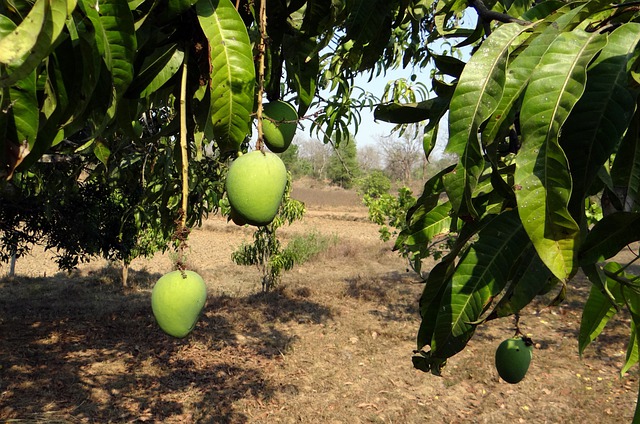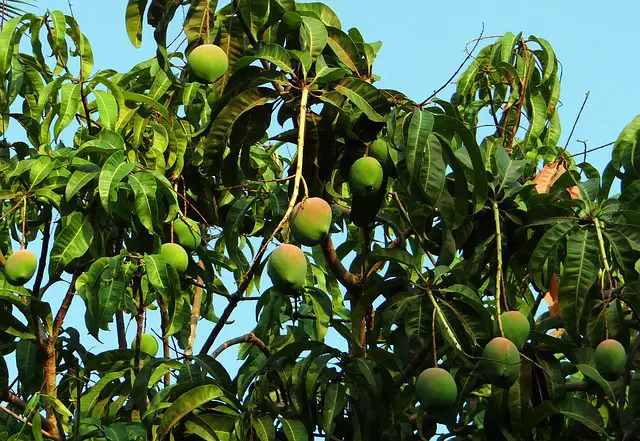Are mango trees evergreen is a top searched query. Growing a mango tree in your own garden is a lovely idea. Mango trees provide us with one of the most popular fruits in the world; plus, they are excellent shade creators, but do they blossom all year round?
Mango trees are evergreens that can tolerate droughts and love the sunshine. However, these plants sometimes drop their leaves during the fall, which causes some people to believe they’re deciduous.
Continue reading to discover whether mangoes are truly evergreen or deciduous and how to tell the difference, plus the reason why mango trees sometimes drop their leaves.
Are Mango Trees Evergreen?

Yes. The botanical classification of a mango tree is evergreen because its leaves do not change color through the fall or drop from the tree. However, mango leaves can periodically drop their leaves due to environmental conditions, which causes large piles of leaf foliage to gather below them.
The mango tree possesses a unique set of evergreen leaves that can grow anywhere between five and sixteen inches long. Young leaves often appear in red, pink, amber, or yellow hues; these leaves darken as the tree ages and become leathery to the touch.
Mature evergreen leaves of the mango tree appear dark and glossy on the topside, with dull, paler green shades underneath. These leaves grow in thick clusters and thus provide ample shade to the environment below.
A mango tree is evergreen because it will maintain this complete covering of leaves throughout the year. They grow best in tropical and subtropical areas with mild winters and humid summers.
Are Mango Trees Deciduous?
The vast majority of deciduous trees drop their leaves during the Winter. While this is easily noticeable in some trees, others are slightly more complex; they drop a lot of leaf litter but do not clean their branches entirely. This is why we can sometimes describe the mango tree as a deciduous plant.
Mango trees grow in hot, tropical climates and thus don’t drop their leaves even through autumn and Winter. But these plants can create a lot of litter thanks to changing seasons, weather conditions, and soil quality.
In this way, mango trees are pretty unique and rely heavily on their surrounding environment to provide the nourishment they need to flourish.
Why Do Mango Trees Drop Their Leaves?

It’s perfectly normal for a mango tree to drop its leaves from time to time; this allows them to refresh their leaves and replace old, dead leaves with fresh, new ones.
The average evergreen leaf of the mango tree will live for around five years (the tree, of course, will live much longer), so once the leaf dies, it will lose its color and drop from the tree. You can use these fallen leaves, rotting fruit, and other natural debris to create a compost pile around the base of your tree for fertilization.
That being said, a mango tree can lose excessive amounts of leaves during times when it faces adverse conditions. For example, mango trees that are exposed to harsh winds or frosty climates will lose more leaves than usual. Mango trees can also shed excess leaves when exposed to excessive heat.
This plant enjoys a tropical and sunny location; still, too much heat on the plant can cause problems. Any extreme weather changes can shock the tree into dropping its leaves. An established and healthy tree can survive one of these “drops,” though they need ample water and the ability to maintain a healthy canopy.
Can You Stop Mango Trees From Dropping Leaves?
When a mango tree is well looked after, its leaves can live for up to five years each, creating less leaf litter through the average year.
A mango tree is a tropical plant that requires a frost-free environment if it is to thrive. If you want to plant a mango tree in your garden, you need to plant it away from other trees and buildings as these plants will become quite large as they mature and require ample room to grow.
A mango tree also requires a good level of air circulation to thrive. If you live in a coastal area or another place with high wind exposure, you should build a wind break to protect your tree from the elements.
How Can I Tell If A Tree Is Evergreen Or Deciduous?
Botanists classify mango trees as evergreen because they always have a green canopy of leaves, thriving in warm, humid, subtropical climates. The mango tree also grows flowers during the spring and fruit during the summer.
Sometimes, people confuse the mango tree as a deciduous plant because of the amount of leaf litter it creates, but dropping leaves doesn’t classify a tree as deciduous.
A deciduous plant loses its entire canopy through the fall and autumn. As the cooler months approach, the leaves of a deciduous tree change color from green to red to yellow before dropping to the ground, leaving the branches bare behind them.
Evergreen trees, like the mango tree, do drop leaves, but this is more of a renewal process. The evergreen leaves remain green throughout the year instead of changing color with the seasons, and the branches of their trees always have foliage.
In addition, deciduous trees have broader leaves than their evergreen counterparts, which helps them to create extra nutrition for their tree to store through the harsh winter months. But because evergreen trees keep their leaves all year round, they can manage with much slimmer ones.
See a similar post: Alocasia Yellow Leaves
Summary
Mango trees are evergreen because their leaves do not change color and drop from the tree as they would from a deciduous plant. Still, mango tree leaves don’t live forever, and it’s not unusual to see a pile of leaf litter beneath a mango tree at certain times of the year.
Frequently Asked Questions
Do mango trees lose their leaves seasonally?
A young mango tree will quickly develop a large canopy that is densely packed with foliage and maintain this foliage throughout its life. The mango tree is botanically classed as an evergreen, though it periodically drops leaves.
These leaf drops are less to do with the seasonal changes that a deciduous plant would experience and more to do with replacing old leaves with new ones. Mango trees drop their leaves periodically, so they don’t follow a seasonal pattern, and they don’t leave the branches bare.
These leaf drops do mean that the underneath of the mango tree can have a messy appearance at any time of the year, though, thanks to its accumulation of leaf litter.
Is mango an evergreen plant?
When we talk about “mango trees,” we talk about the Mangifera indica plant and its fruit. Botanists classify this plant as evergreen because it maintains leafy foliage year round and doesn’t experience leaf color changes and drops during the fall.
The fruit produced by the mango tree varies in taste and appearance; still, it is one of the most popular fruits worldwide.
Is mango a deciduous tree?
In scientific terms, the mango tree is an evergreen plant. Still, this tree does drop its leaves in a way that could lead people to believe it’s deciduous.
The sheer size and volume of the leaves on a mango tree can quickly add to a large pile of leaf litter. Thanks to the weather conditions during the dry autumn and winter months, the tree can lose more leaves than usual, giving the appearance that it could be a deciduous tree.

Hey, I’m Lisa and I’ve been an avid gardener for over 30 years. I love writing, talking and living in the garden! Feel free to connect with me on my socials below

